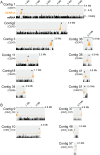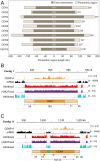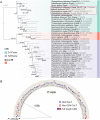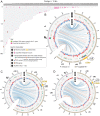Long transposon-rich centromeres in an oomycete reveal divergence of centromere features in Stramenopila-Alveolata-Rhizaria lineages
- PMID: 32150559
- PMCID: PMC7082073
- DOI: 10.1371/journal.pgen.1008646
Long transposon-rich centromeres in an oomycete reveal divergence of centromere features in Stramenopila-Alveolata-Rhizaria lineages
Abstract
Centromeres are chromosomal regions that serve as platforms for kinetochore assembly and spindle attachments, ensuring accurate chromosome segregation during cell division. Despite functional conservation, centromere DNA sequences are diverse and often repetitive, making them challenging to assemble and identify. Here, we describe centromeres in an oomycete Phytophthora sojae by combining long-read sequencing-based genome assembly and chromatin immunoprecipitation for the centromeric histone CENP-A followed by high-throughput sequencing (ChIP-seq). P. sojae centromeres cluster at a single focus at different life stages and during nuclear division. We report an improved genome assembly of the P. sojae reference strain, which enabled identification of 15 enriched CENP-A binding regions as putative centromeres. By focusing on a subset of these regions, we demonstrate that centromeres in P. sojae are regional, spanning 211 to 356 kb. Most of these regions are transposon-rich, poorly transcribed, and lack the histone modification H3K4me2 but are embedded within regions with the heterochromatin marks H3K9me3 and H3K27me3. Strikingly, we discovered a Copia-like transposon (CoLT) that is highly enriched in the CENP-A chromatin. Similar clustered elements are also found in oomycete relatives of P. sojae, and may be applied as a criterion for prediction of oomycete centromeres. This work reveals a divergence of centromere features in oomycetes as compared to other organisms in the Stramenopila-Alveolata-Rhizaria (SAR) supergroup including diatoms and Plasmodium falciparum that have relatively short and simple regional centromeres. Identification of P. sojae centromeres in turn also advances the genome assembly.
Conflict of interest statement
The authors have declared that no competing interests exist.
Figures









Similar articles
-
Ectopic centromere nucleation by CENP--a in fission yeast.Genetics. 2014 Dec;198(4):1433-46. doi: 10.1534/genetics.114.171173. Epub 2014 Oct 7. Genetics. 2014. PMID: 25298518 Free PMC article.
-
Heterochromatin and RNAi regulate centromeres by protecting CENP-A from ubiquitin-mediated degradation.PLoS Genet. 2018 Aug 8;14(8):e1007572. doi: 10.1371/journal.pgen.1007572. eCollection 2018 Aug. PLoS Genet. 2018. PMID: 30089114 Free PMC article.
-
Repeat-Associated Fission Yeast-Like Regional Centromeres in the Ascomycetous Budding Yeast Candida tropicalis.PLoS Genet. 2016 Feb 4;12(2):e1005839. doi: 10.1371/journal.pgen.1005839. eCollection 2016 Feb. PLoS Genet. 2016. PMID: 26845548 Free PMC article.
-
Plasticity in centromere organization and kinetochore composition: Lessons from diversity.Curr Opin Cell Biol. 2022 Feb;74:47-54. doi: 10.1016/j.ceb.2021.12.007. Epub 2022 Feb 2. Curr Opin Cell Biol. 2022. PMID: 35108654 Free PMC article. Review.
-
Transcription and ncRNAs: at the cent(rome)re of kinetochore assembly and maintenance.Chromosome Res. 2013 Dec;21(6-7):643-51. doi: 10.1007/s10577-013-9387-3. Chromosome Res. 2013. PMID: 24190519 Review.
Cited by
-
Repetitive Elements Contribute to the Diversity and Evolution of Centromeres in the Fungal Genus Verticillium.mBio. 2020 Sep 8;11(5):e01714-20. doi: 10.1128/mBio.01714-20. mBio. 2020. PMID: 32900804 Free PMC article.
-
Comparative genomics of Chlamydomonas.Plant Cell. 2021 May 31;33(4):1016-1041. doi: 10.1093/plcell/koab026. Plant Cell. 2021. PMID: 33793842 Free PMC article.
-
Karyotype variation, spontaneous genome rearrangements affecting chemical insensitivity, and expression level polymorphisms in the plant pathogen Phytophthora infestans revealed using its first chromosome-scale assembly.PLoS Pathog. 2022 Oct 10;18(10):e1010869. doi: 10.1371/journal.ppat.1010869. eCollection 2022 Oct. PLoS Pathog. 2022. PMID: 36215336 Free PMC article.
-
A Comprehensive Assessment of the Secretome Responsible for Host Adaptation of the Legume Root Pathogen Aphanomyces euteiches.J Fungi (Basel). 2022 Jan 17;8(1):88. doi: 10.3390/jof8010088. J Fungi (Basel). 2022. PMID: 35050028 Free PMC article.
-
Remote homology clustering identifies lowly conserved families of effector proteins in plant-pathogenic fungi.Microb Genom. 2021 Sep;7(9):000637. doi: 10.1099/mgen.0.000637. Microb Genom. 2021. PMID: 34468307 Free PMC article.
References
Publication types
MeSH terms
Substances
Grants and funding
LinkOut - more resources
Full Text Sources
Molecular Biology Databases
Miscellaneous

